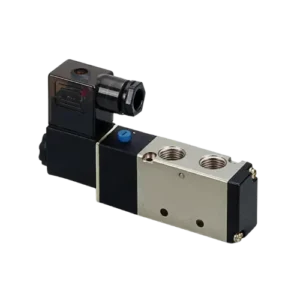Contact : +91-79045 61980 | Email: hydrofitengineers@gmail.com
Pneumatic Single Acting Solenoid Valve
supplier in chennai
Hydrofit Engineers is a proven supplier of high performance single solenoid valves that can be easily integrated while being highly reliable and efficient.
A single acting solenoid valve is a variety of pneumatic solenoid valve that can guide the flow of compressed air with remarkable accuracy. Single acting solenoid valves are commonly used within automation systems because of their fast response time and reliable performance for industrial applications.
Why Choose Our Single Solenoid Valves


- Fast Response – Allow for fast actuation and consistent automation.
- Remote – Easily integrated into electronic control systems for remote control when connected to an electric control system.
- Durable – Designed for long life and consistency of function.
- Energy Efficient – Optimum design allow for reduced air and power usage.
- Versatile – Used in many industries including manufacturing, automotive, and HVAC.
Components of Single Acting Solenoid Valves
- Valve Body – Encases the inlet and outlet ports and provides a solid design structure.
- Solenoid Coil – Produces the magnetic field required to actuate the valve.
- Armature – The armature travels freely within the coil and directs the flow of air through the valve ports when energized.
- Springs – Return the valve to the original position once de-energized.
- Seals and Gaskets – To ensure leak-proof performance and maximum service life.
When in the energized state the coil actuates, drawing the armature and allows compressed air to flow through the valve ports. When the coil is de-energized the armature returns to the resting position, blocking the air passage. This is valuable in pneumatic systems because the design is simple yet effective in providing smooth on/off control.
- Pneumatic Actuation – Cylinders, rotary actuators, and air tools
Automation Systems – Excellent for use in robotics, assembly lines, and packaging machines.
Fluid Power Systems – Control the flow of air and gas in complex control circuits.
HVAC Systems – Control airflow and pressure for heating, cooling, and ventilation.
Industrial Machines – Improve efficiency and precision in production environments.
want best price for Single Acting Solenoid Valves?
Browse all our solenoid valve types for versatile industrial applications
FAQs
What is a single acting solenoid valve?
It is a pneumatic solenoid valve that uses a single port for compressed air input and a single port for outlet. It is designed to switch on and off for flow control. You can know more about solenoid valve here.
Where does single solenoid valves get used?
They are used in Automation, HVAC, pneumatic actuation, fluid power systems and industrial machinery.
What are the benefits of single acting solenoid?
Benefits Include fast response, remote, durable, energy efficient, and versatility across industries.
How do pneumatic solenoid operate?
When power is applied to the solenoid to the coil, it will actuate the armature and allow compressed flow through. When the power is removed, it will return and blockage the flow.
Do you supply custom solenoid valves?
Yes, Hydrofit Engineers provides customized pneumatic solenoid valves to suit specific industrial needs and applications. your can find more details about solenoid valves here.
